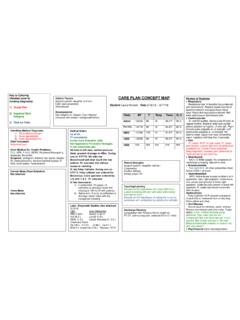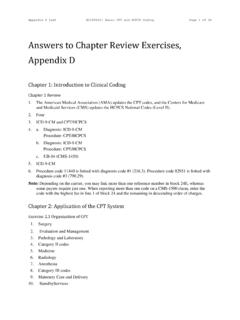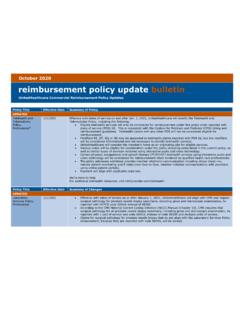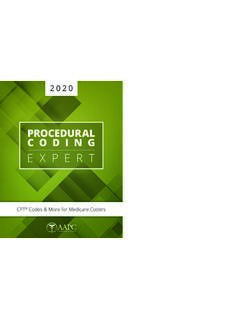Transcription of 12 Errors to Avoid in Coding Skin Procedures
1 January/February 2013 | | FAMILY PRACTICE MANAGEMENT | 1112 Errors to Avoid in Coding skin ProceduresGary N. Fox, MD, and Laura A. McCann, CPC, CCS-P Coding and billing for diagnosing and treat-ing skin lesions is rife with potential pitfalls that could lead to delayed payments at best and increased insurer scrutiny or investiga-tion for fraud at worst. Because skin procedure codes take into account the type of removal, the size and location of the lesion, your intent, and pathologic results, document-ing your service and selecting the right code can be confus-ing.
2 This article explains how to Avoid some of the most common mistakes in skin procedure Coding and provides an encounter form that can help you to more rapidly and accurately report skin -related diagnoses and associated pro-cedures (see the form on page 14). 1 Know the difference between an excision and a excision is a procedure intended to fully remove a lesion. The specimen should include the lesion and the surgical margins. To qualify as an excision, the procedure must be full thickness, which means entirely through the reticular dermis to fat.
3 For example, let s say a lesion appears to be a 4 mm nodular basal cell carcinoma (BCC) or a nevus. An 8 mm punch is used to excise the vis-ible portion of the lesion with apparent 2 mm margins in all directions with the punch carried full thickness. The lesion has been excised. The excision code includes anesthesia and straightforward, simple closure. If the procedure required extensive undermining, a two-layer closure, and removal of excess skin , a separate code for a moderately complex closure should be contrast, a biopsy is a procedure that samples any-thing less than a full lesion, even if full thickness ( inci-sional rather than excisional ).
4 For example, sampling a 1 cm suspected squamous cell carcinoma (SCC) at full thick-ness into subcutaneous fat with a 4 mm punch instrument centrally should be coded as a biopsy. A biopsy code might also be used when sampling one or more of a group of lesions for diagnosis, even if these sample lesions are com-pletely excised, or when taking samples of a dermatitis. SERGE BLOCHU sing the correct codes can mean the difference between getting paid and getting from the Family Practice Management Web site at Copyright 2012 American Academy of Family Physicians.
5 For the private, noncommercial use of one individual user of the Web site . All other rights reserved. Contact for copyright questions and/or permission | FAMILY PRACTICE MANAGEMENT | | January/February 2013 Complete removal does not necessarily mean that an excision code should be used. When the intent is to entirely remove the pathology by anything less than a full thick-ness technique, a shave code may be appro-priate, even if the pathology report confirms complete removal of the lesion.
6 For example, trying to completely remove a nevus or sus-pected melanoma via a scoop or sauceriza-tion technique that extends into the deep dermis and not the fat should be coded as a shave removal, not an excision. 2 Don t overbill for excisions or underbill for primary excision should be billed based on the largest diameter of the lesion plus the nar-rowest lateral margins. For example, a round 4 mm lesion placed centrally in an 8 mm punch has a lesion diameter of 4 mm and 2 mm margins all around.
7 The excision length for this lesion is 8 mm: 4 mm (lesion) plus 2 mm (one narrowest margin) plus 2 mm (other narrowest margin). For an ovoid lesion measuring 8 mm by 4 mm, removed with 2 mm margins across the short diameter and greater margins at the apices to fashion a fusi-form excision closer to the traditional length-to-width ratio of 3:1, the calculation would be 12 mm: 8 mm (lesion) plus 2 mm (narrowest margins counted twice) (see the photo illustra-tion on the next page).The lesion should be measured preopera-tively because tissue tends to change shape or shrink in formalin, which causes pathologic measurement to be generally smaller than the clinical measurement, and some dermapathol-ogy laboratories include that information in their reports.
8 A re-excision is a procedure on any lesion that has been previously biopsied or under-gone an initial excision by you or anyone else. When billing for a re-excision, use the total closed length of the excision to guide your code selection. When a patient presents for a scheduled re-excision, you should bill for the procedure but not the office visit, unless significant, separately identifiable services are provided, in which case you could submit a code for the evaluation and management ser-vice with modifier re-excision shows no residual malig-nancy, you should still bill the malignant lesion diagnosis codes, because that was the purpose of the Know the difference between biopsy and there is a dermatitis.
9 Such as suspected psoriasis, contact dermatitis, or Grover s disease, specimens you obtain for pathology should be classified as biopsies even if the sam-pled lesions are entirely removed using a shave technique. List your suspected diagnosis in your clinical notes, but you should bill using diagnosis code for unspecified disorder of skin and subcutaneous tissue. If you use the code for psoriasis, for example, the insurer may reject the claim and ask why you did a biopsy if you already knew the diagnosis.
10 If you remove and cure a symptomatic seborrheic keratosis via a shave technique, that can be appropriately billed as a shave. If you cannot determine whether a lesion is a seborrheic keratosis or a melanoma and you do a full thickness excision because of concern about melanoma, it is legitimate to bill for excision. It is almost always inappropriate to excise seborrheic keratoses when you are cer-tain of the diagnosis. It is often appropriate to remove them because of symptoms, but only via the shave technique.















